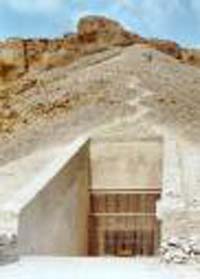New tomb discovered in Valley by American archaeologists
American archaeologists have made the first discovery of a new tomb in Egypt's Valley of the Kings since King Tutankhamun's was uncovered in 1922, Egypt's antiquities chief announced. The 18th Dynasty tomb included five mummies in intact sarcophagi with colored funerary masks along with more than 20 large storage jars, sealed with pharaonic seals, Zahi Hawass, head of the Supreme Council of Antiquities said in a statement.

Still unknown is who the tomb belonged to. U.S. archeologist Kent Weeks, who was not involved in the discovery but has seen photographs of the tomb's interior, said its appearance suggested it did not belong to a king. "It could be the tomb of a king's wife or son, or of a priest or court official," he told The Associated Press on Thursday.
No matter who is in the new tomb, its discovery shatters the nearly century-old perception that there was nothing left to discover in the Valley of the Kings, where it had long been believed that the 62 previously known tombs were all there was, said Weeks, who made the last major discovery in the valley. "It clearly proves that the Valley of the Kings is still not exhausted," he said. "There are problably more tombs to be found in it."
Weeks made the last major discovery in the valley. In 1995, he opened a previously known tomb and found it was far larger than expected: more than 120 chambers, which he determined were tombs for sons of the pharoah Ramses II. The new tomb is a single chamber, meaning it was likely intended for a single mummy, he said. Other sarcophagi or even all of them may have been put in at a later time.
"The objects in the tomb don't necessarily date to the original tomb. It is not unknown for a tomb to be used as a storeroom for other materials," he said. "The objects could be 200 to 400 years later than the orginial cutting of the tomb. Some could be original, some may have been introduced later."
It is known that in later dynasties, high priests fearing grave robbers took mummies from their original sites and stashed them in other tombs or locations or even after the pharoanic area, mummies were moved either to protect them or to hide them for later theft, he said.
Hawass did not specify who was believed buried in the tomb. The antiquities chief was scheduled to visit the site Friday to announce more details. A University of Memphis team of archaeologists led by Otto Schaden found the tomb four meters (yards) below the ground, buried under rubble and stones five meters (yards) away from Tut's tomb, the statement by Hawass said.
Inside the rectangular tomb, the five wooden sarcophagi were surrounded by the jars, which appeared placed haphazardly, suggesting the burial was completed quickly, the statement by Hawass said. The 18th Dynasty, from around 1500 BC to 1300 BC, was the first dynasty of the New Kingdom, the pharaonic empire than lasted until around 1000 BC and made its capital in Thebes the present day city of Luxor, 500 kilometers (300 miles) south of Cairo. The Valley of the Kings was used as a burial ground throughout the New Kingdom, though contrary to its name not all the tombs are of kings, reports the AP.
N.U.
Subscribe to Pravda.Ru Telegram channel, Facebook, RSS!


